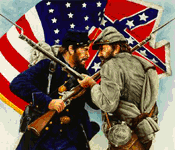 |
Civil War Battles |
|
State War Records |
| AL - AK - AZ - AR - CA - CO - CT - DE - FL - GA - HI - ID - IL - IN - IA - KS - KY - LA - MA - MD - ME - MI - MN - MS - MO - MT - NE - NV - NH - NJ - NM - NY - NC - ND - OH - OK - OR - PA - RI - SC - SD - TN - TX - UT - VT - VA - WA - WV - WI - WY |
The Battle of Chattahootchie River
July 3-9, 1864 on the Chattahootchie River near Atlanta, Georgia
 |
|||||||||||||||||||||
|
By July 1st, rains slowing the armies of Maj. Gen. William T. Sherman above Atlanta had ended and the Federals were once again on the move. That day Sherman renewed his tried-and-true strategy of threatening the left flank of Gen. Joseph E. Johnston's Army of Tennessee, compelling the Confederates to fall back south, ever closer to Atlanta. By early on the 3rd, Johnston had withdrawn from his position near Marietta to works previously constructed astride the Western & Atlantic Railroad near Smyrna.
Pursuing doggedly, Sherman probed the new position, then celebrated Independence Day by striking the same flank he had threatened 3 days before. Firefights broke out north and west of Smyrna, then south of the town near the rail depot of Vining's Station. The force of Confederate resistence somewhat surprised Sherman. He had not expected Johnston to make a stand north of the nearby Chattahootchie River but to cross that stream and dig in near Atlanta. Late that day, johnston retreated farther, sending his wagons and rear guards across the river and building bridges on which to cross his main body. The latter, however, he placed behind another strong line of works along the north bank of the river and appeared ready for another confrontation. If Sherman wanted the Confederates to pass over the Chattahootchie, he would have to persuade them violently.
This placed Sherman in a delimma. His disastrous decision to attack frontally against Johnston at Kennesaw Mountain on June 27th, had left him wary of direct offensives, especially against strong, fixed positions. But he hesitated only briefly and early on the 5th he moved Maj. Gen. George H. Thomas' Army of the Cumberland into place opposite Johnston's bridgehead, holding the Confederates in place. Meanwhile, he sent the cavalry of the Army of the Ohio, under Maj. Gen. George Stoneman, and Maj. Gen. James B. McPherson's Army of the Tennessee once more toward the Confederates left, as though to cross the river at Turner's Ferry, a half-dozen miles downstream from Johnston's main body. At the same time, part of Maj. Gen. John M. Schofield's XXIII Corps- his 3rd Division, under Brig. Gen. Jacob D. Cox- readied a surprise crossing and equal distance upstream near Phillips' Ferry, by the mouth of Soap Creek.
At midafternoon on the 8th, as McPherson and Stoneman demonstrated near Turner's Ferry, one of Schofield's regiments paddled across the Chattahootchie in pontoons. The crossing was covered so well that a small force of Confederate cavalry, with 1 cannon, which provided the only opposition, was easily repulsed. Another of Cox's brigades then forded the stream a mile above the first crossing, occupied a high ridge on the other side, and established a foothold along the Confederate right. Later, the pontoons were used to construct a bridge over which the whole of Schofield's corps crossed. The next morning, the cavalry division of Brig. Gen. Kenner Garrard splashed across farther upriver, near Rosswell, supported by 1 of McPherson's corps and a division detached from Thomas' army.
These several dispositions had the desired effect. On the evening of the 9th, the Army of Tennessee evacuated its defenses and crossed the Chattahootchie, removing the last great natural barrier between Sherman and Atlanta. The crossing had another valuable benefit for Sherman: distressed by Johnston's Fabian policies, the Confederate War Department soon relieved him of command. By removing an opponent he considered wily and stubborn, Sherman felt the authorities in Richmond had "rendered us most valuable service".
